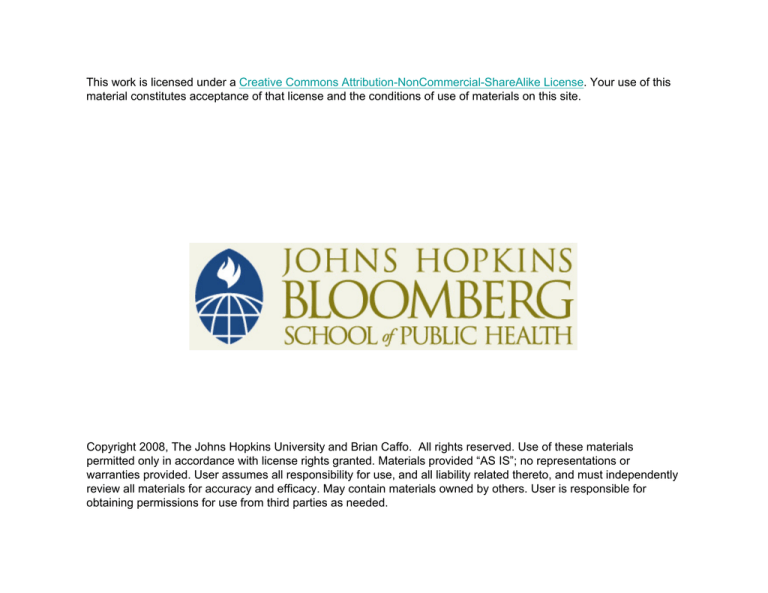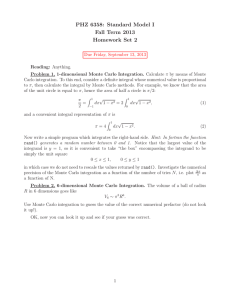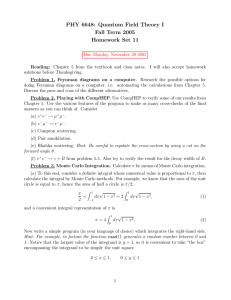
This work is licensed under a Creative Commons Attribution-NonCommercial-ShareAlike License. Your use of this
material constitutes acceptance of that license and the conditions of use of materials on this site.
Copyright 2008, The Johns Hopkins University and Brian Caffo. All rights reserved. Use of these materials
permitted only in accordance with license rights granted. Materials provided “AS IS”; no representations or
warranties provided. User assumes all responsibility for use, and all liability related thereto, and must independently
review all materials for accuracy and efficacy. May contain materials owned by others. User is responsible for
obtaining permissions for use from third parties as needed.
Lecture 26
Brian Caffo
Table of
contents
Outline
Nonparametric
tests
Lecture 26
Sign test
Signed rank
test
Brian Caffo
Monte Carlo
Independent
groups
Mann/Whitney
test
Monte Carlo
Permutation
tests
Department of Biostatistics
Johns Hopkins Bloomberg School of Public Health
Johns Hopkins University
December 19, 2007
Lecture 26
Table of contents
Brian Caffo
Table of
contents
1 Table of contents
Outline
Nonparametric
tests
Sign test
Signed rank
test
2 Outline
3 Nonparametric tests
4 Sign test
Monte Carlo
Independent
groups
5 Signed rank test
Mann/Whitney
test
6 Monte Carlo
Monte Carlo
7 Independent groups
Permutation
tests
8 Mann/Whitney test
9 Monte Carlo
10 Permutation tests
Lecture 26
Outline
Brian Caffo
Table of
contents
Outline
Nonparametric
tests
Sign test
Signed rank
test
Monte Carlo
Independent
groups
Mann/Whitney
test
Monte Carlo
Permutation
tests
1
Distribution-free tests
2
Sign test
3
Sign rank test
4
Rank sum test
5
Discussion of non-parametric tests
Lecture 26
Nonparametric tests
Brian Caffo
Table of
contents
Outline
Nonparametric
tests
Sign test
Signed rank
test
Monte Carlo
Independent
groups
Mann/Whitney
test
Monte Carlo
Permutation
tests
• “Distribution free” methods require fewer assumptions
than parametric methods
• Focus on testing rather than estimation
• Not sensitive to outlying observations
• Especially useful for cruder data (like ranks)
• “Throws away” some of the information in the data
• May be less powerful than parametric counterparts, when
the parametric assumptions are true
• For large samples, are equally efficient to parametric
counterparts
Lecture 26
Brian Caffo
Table of
contents
Outline
Nonparametric
tests
Sign test
Signed rank
test
Monte Carlo
Independent
groups
Mann/Whitney
test
Monte Carlo
Permutation
tests
Fish
1
2
3
4
5
6
7
8
9
10
11
12
SR
.32
.40
.11
.47
.32
.35
.32
.63
.50
.60
.38
.46
P
.39
.47
.11
.43
.42
.30
.43
.98
.86
.79
.33
.45
Diff
.07
.07
.00
-.04
.10
-.05
.11
.35
.36
.19
-.05
-.01
Sgn rank
+15.5
+15.5
Fish
SR
13
.20
14
.31
15
.62
-11.0
16
.52
+20.0
17
.77
-13.5
18
.23
+20.0
19
.30
+23.0
20
.70
+24.0
21
.41
+22.0
22
.53
-13.5
23
.19
-2.5
24
.31
25
.48
Measurements are mecury levels in fish (ppm)
P
.22
.30
.60
.53
.85
.21
.33
.57
.43
.49
.20
.35
.40
Diff
.02
-.01
-.02
.01
.08
-.02
.03
-.13
.02
-.04
.01
.04
-.08
Sng rank
+6.5
-2.5
-6.5
+2.5
+17.5
-6.5
+9.0
-21.0
+6.5
-11.0
+2.5
+11.0
-17.5
Data from Rice Mathematical Statistics and Data Analysis; second
edition
Lecture 26
Brian Caffo
Alternatives to the paired t-test
Table of
contents
Outline
Nonparametric
tests
Sign test
• Let Di = difference (P - SR)
Signed rank
test
• Let θ be the population median of the Di
Monte Carlo
Independent
groups
Mann/Whitney
test
• H0 : θ = 0 versus Ha : θ 6= 0 (or > or <)
• Notice that θ = 0 iff p = P(D > 0) = .5
• Let X be the number of times D > 0
• X is then binomial(n, p)
Monte Carlo
Permutation
tests
• The sign test tests wether H0 : p = .5 using X
Lecture 26
Example
Brian Caffo
Table of
contents
Outline
Nonparametric
tests
• θ = median difference p - sr
Sign test
• H0 : θ = 0 versus Ha : θ 6= 0
Signed rank
test
• Number of instances where the difference is bigger than 0
Monte Carlo
is 15 out of 25 trials
Independent
groups
• binom.test(15, 25)
Mann/Whitney
test
Monte Carlo
Permutation
tests
p-value = 0.4244
• Or we could have used large sample tests for a binomial
proportion prop.test(15, 25, p = .5)
X-squared = 0.64, df = 1, p-value = 0.4237
Lecture 26
Discussion
Brian Caffo
Table of
contents
Outline
Nonparametric
tests
Sign test
Signed rank
test
Monte Carlo
Independent
groups
Mann/Whitney
test
Monte Carlo
Permutation
tests
• Magnitude of the differences is discarded
• Perhaps too much information lost
• Could easily have tested H0 : θ = θ0 by calculating the
number of times D > θ0 and performing a binomial test
• We can invert these tests to get a distribution free
confidence interval for the median
Lecture 26
Signed rank test
Brian Caffo
Table of
contents
Outline
Nonparametric
tests
Sign test
Signed rank
test
Monte Carlo
Independent
groups
Mann/Whitney
test
Monte Carlo
Permutation
tests
• Wilcoxon’s statistic uses the information in the signed
ranks of the differences
• Saves some of the information regarding the magnitude of
the differences
• Still tests H0 : θ = 0 versus the three alternatives
• Appropriately normalized, the test statistic follows a
normal distribution
• Also the exact small sample distribution of the signed rank
statistic is known (if there are no ties)
Lecture 26
Signed rank procedure
Brian Caffo
Table of
contents
Outline
Nonparametric
tests
Sign test
Signed rank
test
Monte Carlo
Independent
groups
1
Take the paired differences
2
Take the absolute values of the differences
3
Rank these absolute values, throwing out the 0s
4
Multiply the ranks by the sign of the difference (+1 for a
positive difference and -1 for a negative difference)
5
Cacluate the rank sum W+ of the positive ranks
Mann/Whitney
test
Monte Carlo
Permutation
tests
Lecture 26
Signed rank procedure
Brian Caffo
Table of
contents
Outline
Nonparametric
tests
Sign test
Signed rank
test
Monte Carlo
Independent
groups
Mann/Whitney
test
• If θ > 0 then W+ should be large
• If θ < 0 then W+ should be small
• Properly normalized, W+ follows a large sample normal
distribution
• For small sample sizes, W+ has an exact distribution
under the null hypothesis
Monte Carlo
Permutation
tests
• Can get critical values from tables in the textbook
Lecture 26
Monte Carlo
Brian Caffo
Table of
contents
Outline
Nonparametric
tests
Sign test
Signed rank
test
Monte Carlo
Independent
groups
Mann/Whitney
test
Monte Carlo
Permutation
tests
• Assume no ties
• Simulate n observations from any distribution that has
θ = 0 as its median
• Rank the absolute value of the data, retain the signs,
calculate the signed rank statistic
• Apply this procedure over and over, the proportion of time
that the observed test statistic is larger or smaller
(depending on the hypothesis) is a Monte Carlo
approximation to the P-value
Lecture 26
Monte Carlo
Brian Caffo
Table of
contents
Outline
Nonparametric
tests
Sign test
Signed rank
test
Monte Carlo
Independent
groups
Mann/Whitney
test
Monte Carlo
Permutation
tests
• Here’s a slightly more elegant way to simulate from the
null distribution
• Consider the ranks 1, . . . , n
• Randomly assign the signs as binary with probability .5 of
being positive and .5 of being negative
• Calculate the signed rank statistic
• Apply this procedure over and over, the proportion of time
that the observed test statistic is larger or smaller
(depending on the hypothesis) is a Monte Carlo
approximation to the P-value
Lecture 26
Large sample distribution of W+
Brian Caffo
Table of
contents
Outline
Nonparametric
tests
Sign test
Signed rank
test
Monte Carlo
Independent
groups
Mann/Whitney
test
Monte Carlo
Permutation
tests
• Under H0 and if there are no ties
• E (W+ ) = n(n + 1)/4
• Var (W+ ) = n(n + 1)(2n + 1)/24
• TS = {W+ − E (W+ )}/Sd(W+ ) → Normal(0, 1)
• There is a correction term necessary for ties
• Without ties, it’s possible to do an exact (small sample)
test
Lecture 26
Example
Brian Caffo
Table of
contents
Outline
Nonparametric
tests
Sign test
Signed rank
test
Monte Carlo
Independent
groups
Mann/Whitney
test
Monte Carlo
Permutation
tests
diff <- c(.07, .07, .00, -.04, ...)
wilcox.test(diff, exact = FALSE)
• H0 : Med diff = 0 vesus Ha : Med diff 6= 0
• W+ = 194.5
• E (W+ ) = 24 × 25/4 = 150
• Var(W+ ) = 24 × 25 × 49/24 = 1, 225
√
• TS = (194.5 − 150)/ 1, 224 = 1.27
• P-value = .20
• R’s P-value (uses correction for ties) = 0.21
Lecture 26
Brian Caffo
Methods for unpaired samples
Table of
contents
Outline
Nonparametric
tests
Sign test
Signed rank
test
Monte Carlo
Independent
groups
Mann/Whitney
test
Monte Carlo
Permutation
tests
Comparing two measuring techniques A and B
Units are in deg C per gram
Method A
79.98 80.05
80.04 80.03
80.02 80.02
80.04 80.00
80.03 80.02
80.03
80.04
79.97
Method B
80.02
79.94
79.98
79.97
79.97
80.03
79.95
79.97
Data from Rice Mathematical Statistics and Data Analysis;
second edition
Lecture 26
The Mann/Whitney test
Brian Caffo
Table of
contents
Outline
Nonparametric
tests
Sign test
Signed rank
test
Monte Carlo
Independent
groups
Mann/Whitney
test
Monte Carlo
Permutation
tests
• Tests whether or not the two treatments have the same
location
• Assumes independent identically distributed errors, not
necessarily normal
• Null hypothesis can also be written more generally as a
stochastic shift for two arbitrary distributions
• Test uses the sum of the ranks obtained by discarding the
treatment labels
• Also called the Wilcoxon rank sum test
Lecture 26
Brian Caffo
The Mann-Whitney test
Table of
contents
Outline
Nonparametric
tests
Sign test
Signed rank
test
Monte Carlo
Independent
groups
Mann/Whitney
test
Monte Carlo
Permutation
tests
• Procedure
1 Discard the treatment labels
2 Rank the observations
3 Calculate the sum of the ranks in the first treatment
4 Either
• calculate the asymptotic normal distrubtion of this
statistic
• compare with the exact distribution under the null
hypothesis
Lecture 26
Brian Caffo
Table of
contents
Outline
Nonparametric
tests
Sign test
Signed rank
test
Monte Carlo
Independent
groups
Mann/Whitney
test
Monte Carlo
Permutation
tests
Method A
7.5 21.0
19.0 15.5
11.5 11.5
19.0 9.0
15.5 11.5
15.5
19.0
4.5
180
Method B
11.5
1.0
7.5
4.5
4.5
15.5
2.0
4.5
51
Sum has to add up to 21 × 22/2 = 231
Lecture 26
Aside
Brian Caffo
Table of
contents
Outline
Nonparametric
tests
Sign test
Signed rank
test
Gauss supposedly came up with this in grade school
x =
x =
1
n
+
+
2
n-1
+
+
3
n-2
+
+
4
n-3
+
+
...
...
+
+
n
1
Monte Carlo
Independent
groups
Therefore
2x = n+1
+
n+1
+
Mann/Whitney
test
Monte Carlo
So 2x = n (n + 1) / 2
Permutation
tests
So x = n (n + 1) / 2
n+1
+
n+1
+
...
+
n+1
Lecture 26
Brian Caffo
Results
Table of
contents
Outline
Nonparametric
tests
Sign test
Signed rank
test
Monte Carlo
Independent
groups
Mann/Whitney
test
Monte Carlo
Permutation
tests
• Let W be the sum of the ranks for the first treatment (A)
• Let nA and nB be the sample sizes
• Then
• E (W ) = nA (nA + nB + 1)/2
• Var(W ) = nA nB (nA + nB + 1)/12
• TS = {W − E (W )}/Sd(W ) → N(0, 1)
• Also the exact distribution of W can be calculated
Lecture 26
Example
Brian Caffo
Table of
contents
Outline
Nonparametric
tests
Sign test
Signed rank
test
Monte Carlo
Independent
groups
• W = 51
• E (W ) = 8(8 + 13 + 1)/2 = 88
• Sd(W ) =
p
8 × 13(8 + 13 + 1)/12 = 13.8
• TS = (51 − 88)/13.8 = −2.68
Mann/Whitney
test
• Two-sided P-value= .007
Monte Carlo
• R function wilcox.test will perform the test
Permutation
tests
Lecture 26
Monte Carlo
Brian Caffo
Table of
contents
Outline
Nonparametric
tests
Sign test
Signed rank
test
Monte Carlo
Independent
groups
Mann/Whitney
test
• Note that under H0 , the two groups are exchangeable
• Therefore, any allocation of the ranks between the two
groups is equally likely
• Procedure: Take the ranks 1, . . . , NA + NB and permute
them
• Take the first NA ranks and allocate them to Group A;
allocate the remainder to Group B
Monte Carlo
• Calculate the test statistic
Permutation
tests
• Repeat this process over and over; the proportion of times
the test statistic is larger or smaller (depending on the
alternative) than the observed value is an exact P-value
Lecture 26
Notes about nonpar tests
Brian Caffo
Table of
contents
Outline
Nonparametric
tests
Sign test
Signed rank
test
Monte Carlo
Independent
groups
Mann/Whitney
test
Monte Carlo
Permutation
tests
• Tend to be more robust to outliers than parametric
counterparts
• Do not require normality assumptions
• Usually have exact small-sample versions
• Are often based on ranks rather than the raw data
• Loss in power over parametric counterparts is often not
bad
• Nonpar tests are not assumption free
Lecture 26
Permutation tests
Brian Caffo
Table of
contents
Outline
Nonparametric
tests
Sign test
• Permutation tests are similar to the rank-sum tests,
though they use the actual data rather than the ranks
• That is, consider the null hypothesis that the distribution
of the observations from each group is the same
Signed rank
test
• Then, the group labels are irrelevant
Monte Carlo
• We then discard the group levels and permute the
Independent
groups
Mann/Whitney
test
Monte Carlo
Permutation
tests
combined data
• Split the permuted data into two groups with nA and nB
observations (say by always treating the first nA
observations as the first group)
• Evaluate the probability of getting a statistic as large or
large than the one observed
• An example statistic would be the difference in the
averages between the two groups; one could also use a
t-statistic
Lecture 26
Brian Caffo
Table of
contents
Outline
Nonparametric
tests
Sign test
• This is an easy way to produce a null distribution for a
test of equal distributions
Signed rank
test
• Similar in flavor to the bootstrap
Monte Carlo
• This procedure produces an exact test
Independent
groups
• Less robust, but more powerful than the rank sum tests
Mann/Whitney
test
• Very popular in genomic applications
Monte Carlo
Permutation
tests
Lecture 26
Brian Caffo
Histogram of simTheta
250
Table of
contents
Outline
Independent
groups
Mann/Whitney
test
Frequency
Monte Carlo
100
Signed rank
test
50
Sign test
150
200
Nonparametric
tests
Permutation
tests
0
Monte Carlo
−10
−5
0
simTheta
5
10







